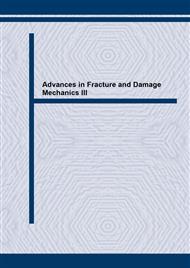[1]
R. Thumser, J. Bergmann, M. Vormwald: Residual stress fields and fatigue analysis of autofrettaged parts, International Journal of Pressure Vessels and Piping (2002) 113-114
DOI: 10.1016/s0308-0161(01)00137-5
Google Scholar
[2]
J. Grosch, D.Liedtke, H.Bomas, H. Streng: Einsatzhärten Expert Verlag, (1994)
Google Scholar
[3]
L. Gurson: Continuum theory of ductile rupture by void nucleation and growth, Part I - yield criteria and flow rules for porous ductile media, J.Engng.Mater.Technol. 99 (1977), 2-15
DOI: 10.2172/7351470
Google Scholar
[4]
U. Mühlich, Th. Siegmund, W. Brocks: A User-Material Subroutine of the Modified GursonTvergaard- Needleman-Model of Porous Metal Plasticity for Rate and Temperature Dependent Hardening
Google Scholar
[5]
G. Bernauer, W. Brocks, U. Mühlich, D. Steglich, M. Werwer: Hinweise zur Anwendung des GTN - Modells, 1999, GKSS/WMG/99/10 Forschungszentrum Geesthacht
Google Scholar
[6]
V. Tvergaard, A. Needleman: Analysis of the cupcone fracture in a round tensile bar, Acta. Metall. 32, 157-169
DOI: 10.1016/0001-6160(84)90213-x
Google Scholar
[7]
G. Bernauer: Einsatz mikromechanischer Schädigungsmodelle im spröd - duktilen Übergangsbereich. 1997, Fakultät für Maschinenbau der Universität Karlsruhe
Google Scholar
[8]
M.H. Pensky: Beschreibung von streuendem Materialverhalten und von Schädigung bei inelastischen Werkstoffen. Bericht Nr. 2000-89. Institut für Statik, Technische Universität Braunschweig 2000 Fig. 6: Crack growth curve of a keyhole- specimen, 17 CrNiMo 6 0 0,5 1 1,5 2 2,5 3 0 2 4 6 8 10 12 14 16 18 20 DDDD a [mm] load-line-displacement [mm] l/h = 0.2/0.4 mm l/h = 0.1/0.4 mm l/h = 0.1/0.2 mm l/h = 0.2/0.2 mm measured crack length (compliance method)
DOI: 10.31030/1465376
Google Scholar
[9]
A. Needleman, V. Tvergaard: An analysis of ductile rupture in notched bars, J. Mech. Phys. Solids 32, 461-490
DOI: 10.1016/0022-5096(84)90031-0
Google Scholar


